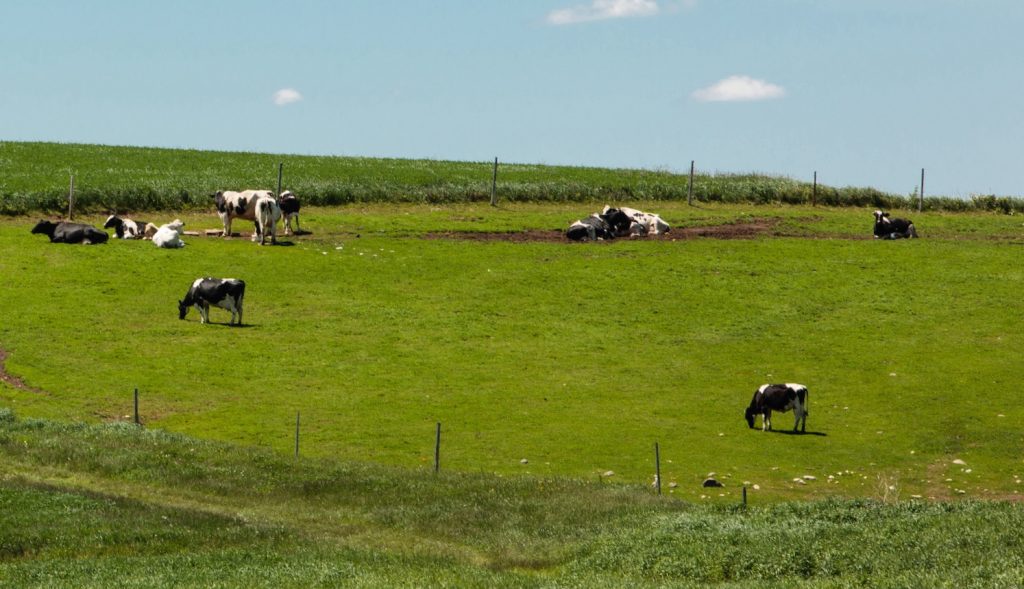Wisconsin Republicans and Democrats are coming together to help farmers put more livestock out on grazing pasture. The Senate and Assembly recently introduced legislation to create a “Transition to Grass” program at the Department of Agriculture, Trade and Consumer Protection that provides grant money and technical assistance to help farmers establish managed grazing systems for livestock on their land. The program is a priority of the Clean Water Initiative, a joint effort from Clean Wisconsin, the Dairy Business Association (DBA), the Nature Conservancy and WI Land+Water to find common ground on water and agricultural issues.
Managed grazing is a farming practice where livestock are systematically rotated through pastureland to optimize their nutrition and the land’s health. In addition to providing excellent nutrition to pastured livestock, managed grazing on perennial grasslands provides significant soil health and water quality benefits. The pastureland acts like a sponge, capturing and filtering fertilizer and pesticides, reducing flooding in rural areas by absorbing stormwater, and building soil and organic matter.
While many of Wisconsin’s beef producers do practice some form of grazing, less than 25% of dairy operations graze even a portion of their dairy herd. Senate Bill 619 and Assembly Bill 655 will ensure more farmers get the financial and technical help they need to take advantage of this beneficial water quality and livestock production practice.
Thank you Rep. Todd Novak, Sen. Jesse James, and all the legislators who have supported this important effort so far. Clean Water Initiative partner groups hope to see widespread support as this bill makes its way through the legislative process. The bills have been referred to the agriculture committees in both the Assembly and Senate. The Clean Water Initiative is glad to see the program is already getting a hearing in the Assembly Agriculture Committee on Tuesday, Nov. 21, and is hopeful the bill will also be taken up in the Senate Ag Committee in the coming weeks.
“Putting livestock out on the land may sound like a move back to a simpler time, but it’s actually a sensible way for farmers to protect our environment, resulting in healthier soil and waterways and animals,” said Clean Wisconsin Water and Agriculture Program Director Sara Walling. “Farmers who want to transition some or all of their livestock to a managed grazing system will have support they need to diversify their operations and adopt more sustainable land management practices. This bill is a win for all of us.”
“Wisconsin is home to dairy farms of all types and sizes,” said DBA CEO Tim Trotter. “This legislation provides incentives for farmers to try something different and find what works best for them. We firmly believe in encouraging farmer-led innovation rather than overly prescriptive rules dictating how farmers should run their business.”
“Grazing lands total about 775 million acres in America yet are some of the least protected spaces in our state,” said Matt Dallman, Deputy State Director of The Nature Conservancy in Wisconsin. “Incentivizing farmers to adopt regenerative grazing practices results in more diverse habitats for critical species, soil capturing more carbon, cleaner water, and a stronger rural economy.”
“Dairy and beef processors in Wisconsin need a better pathway to managed rotational grazing,” said WI Land+Water Executive Director Matt Krueger. “This bill provides that, and also helps our landscape become more resilient to large storm events and subsequent flooding.”
More about the bills
The Transition to Grass program will provide grants to farmers to:
- Assist with establishing perennial forages for rotational grazing of livestock on marginal areas of the farm to provide supplemental feed for the animals.
- Provide technical assistance through certified grazing specialists to develop grazing plans, including support determining field and paddock layout, infrastructure setup, seed selection, and establishment of rotational grazing patterns.
- Provide financial assistance for managed grazing system infrastructure needs, including fencing, watering, and other livestock management infrastructure, as well as incentives to offset costs for any implementation challenges during the first three years of pasture establishment.
- Assist farmers in navigating grass-based grazing system and grass-fed livestock research, market development initiatives, and market opportunities to meet consumer demand for grass-fed livestock products

